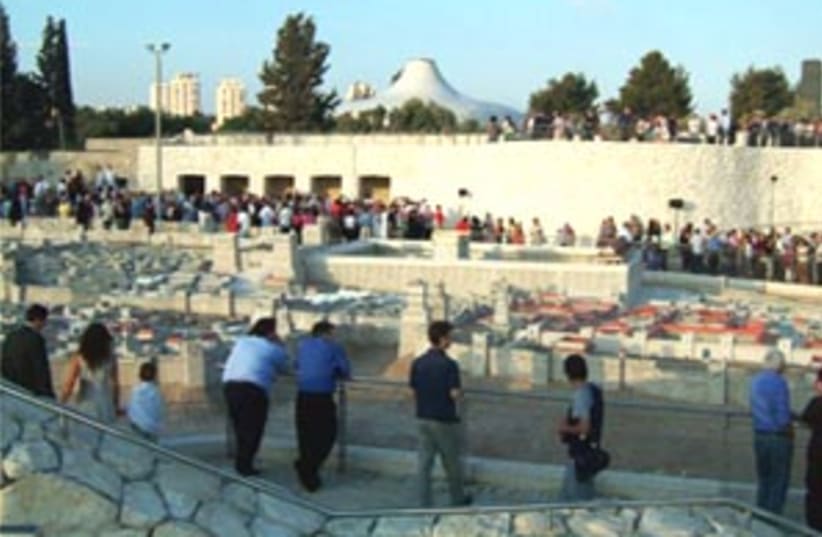At a re-dedication ceremony in early July, noted Israeli archeologist Dan Bahat offerred his first impressions.
"I'm thrilled with the new setting," Bahat told The Christian Edition. "The topography is the biggest improvement, as it more resembles the steep slopes of the Kidron and Hinnom valleys on either side of the city."
"I'm very impressed," agrees Avi Eitan, former director of the state antiquities department and once curator of The Israel Museum. "The location is well chosen, and the impact is even better."
Bahat was still an archeology student 40 years ago when he heard that the model had opened, and came to see it. "I found the model fascinating; it inspired me to start studying Jerusalem to see how accurate it was."
He would later excavate Herod's Palace and find the remains of an ancient bridge over the Tryopean valley linking the wealthy western side of town to the Temple Mount.
The model was originally built over a four-year period at a scale of 50:1 on the grounds of the Holyland Hotel, under the direction of Prof. Michael Avi-Yonah of The Hebrew University. Hotel owner Hans Kroch commissioned it in memory of his son Jacob, who fell in the 1948 War of Independence.
His grandchildren are now leveling the hotel to make room for a luxury apartment complex. The family financed the model's move, which was completed by cutting it into 1,000 one-meter squares and transporting them piece by piece. The Temple was the last section put in place.
The overall project carried a price tag of over $3.5 million.
The model recreates Jerusalem as it was in 66 CE, when the Jewish revolt against Rome first stirred. The city walls during the Herodian period actually encompassed twice as much area as the Old City today. The design is based on ancient writings - especially the works of Jewish historian Josephus Flavius, the Gospels and the Talmud - along with modern archeological finds and contemporary Roman cities.
Very few changes were made to the model during the move, despite 40 years of new discoveries. Dr. Joan Westenholz, curator of the Bible Lands Museum next door, is among those who contend more modifications should have been made, but this is a field where the experts rarely reach a consensus.
"We know the Antonio Fortress was smaller than the model shows, and that the three towers near David's Citadel are also off," explains Bahat. "But I agree with the decision to leave them alone. This is not supposed to be an exact scientific replica, but a teaching tool. Visiting Christians should see it first thing to understand the Jerusalem of Jesus."
Bahat notes the removal of the Hippodrome, which he believes was accurate. He also thinks the Pool of Siloam should have been added, since its location was recently verified.
Perhaps the biggest dispute is over the use of red-tiled roofs on homes in the affluent neighborhoods. Bahat explains that since no complete homes have ever surfaced in Jerusalem, Prof. Avi-Yonah patterned the model's residences on intact houses found buried in the ruins of Pompeii. He adds that red tile fragments have been unearthed near the Cardo - the ancient Roman promenade through the center of town.
Israel Museum director James Snyder is delighted to host the model, which opens alongside a new $2.5 million underground study center for the Dead Sea Scrolls. "It's as if the hand of God wanted the site to remain empty for the model," he said recently.
(From the August 2006 edition)
